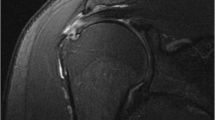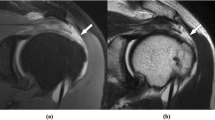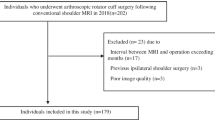Abstract
We assessed the diagnostic performance of magnetic resonance (MR) arthrography in the diagnosis of articular-sided partial-thickness and full-thickness rotator cuff tears in a large symptomatic population. MR arthrograms obtained in 275 patients including a study group of 139 patients with rotator cuff tears proved by arthroscopy and a control group of 136 patients with arthroscopically intact rotator cuff tendons were reviewed in random order. MR imaging was performed on a 1.0 T system (Magnetom Expert, Siemens). MR arthrograms were analyzed by two radiologists in consensus for articular-sided partial-thickness and full-thickness tears of the supraspinatus, infraspinatus, and subscapularis tendons. At arthroscopy, 197 rotator cuff tears were diagnosed, including 105 partial-thickness (93 supraspinatus, nine infraspinatus, three subscapularis) and 92 full-thickness (43 supraspinatus, 20 infraspinatus, 29 subscapularis) tendon tears. For full-thickness tears, sensitivity, specificity, and accuracy were 96%, 99%, and 98%, respectively, and for partial tears 80%, 97%, and 95%, respectively. False negative and positive assessments in the diagnosis of articular-sided partial-thickness tears were predominantly [78% (35/45)] observed with small articular-sided (Ellman grade1) tendon tears. MR arthrography is highly accurate in the diagnosis of full-thickness rotator cuff tears and is accurate in the diagnosis of articular-sided partial-thickness tears. Limitations in the diagnosis of partial-thickness tears are mainly restricted to small articular-sided tears (Ellman grade 1) due to difficulties in differentiation between fiber tearing, tendinitis, synovitic changes, and superficial fraying at tendon margins.







Similar content being viewed by others

References
Fukuda H (2003) The management of partial-thickness tears of the rotator cuff. J Bone Joint Surg Br 85:3–11
Gartsman GM, Milne JC (1995) Articular surface partial-thickness rotator cuff tears. J Shoulder Elbow Surg 4:409–415
Andrews JR, Broussard TS, Carson WG (1985) Arthroscopy of the shoulder in the management of partial tears of the rotator cuff: a preliminary report. Arthroscopy 1:117–122
Jobe CM (1996) Superior glenoid impingement. Current concepts. Clin Orthop Relat Res 98–107
Neer CS (1983) Impingement lesions. Clin Orthop Relat Res 70–77
Balich SM, Sheley RC, Brown TR, Sauser DD, Quinn SF (1997) MR imaging of the rotator cuff tendon: interobserver agreement and analysis of interpretive errors. Radiology 204:191–194
Brenneke SL, Morgan CJ (1992) Evaluation of ultrasonography as a diagnostic technique in the assessment of rotator cuff tendon tears. Am J Sports Med 20:287–289
Hodler J, Kursunoglu-Brahme S, Snyder SJ, Cervilla V, Karzel RP, Schweitzer ME, Flannigan BD, Resnick D (1992) Rotator cuff disease: assessment with MR arthrography versus standard MR imaging in 36 patients with arthroscopic confirmation. Radiology 182:431–436
Nelson MC, Leather GP, Nirschl RP, Pettrone FA, Freedman MT (1991) Evaluation of the painful shoulder. A prospective comparison of magnetic resonance imaging, computerized tomographic arthrography, ultrasonography, and operative findings. J Bone Joint Surg Am 73:707–716
Quinn SF, Sheley RC, Demlow TA, Szumowski J (1995) Rotator cuff tendon tears: evaluation with fat-suppressed MR imaging with arthroscopic correlation in 100 patients. Radiology 195:497–500
Teefey SA, Middleton WD, Payne WT, Yamaguchi K (2005) Detection and measurement of rotator cuff tears with sonography: analysis of diagnostic errors. AJR Am J Roentgenol 184:1768–1773
Teefey SA, Hasan SA, Middleton WD, Patel M, Wright RW, Yamaguchi K (2000) Ultrasonography of the rotator cuff. A comparison of ultrasonographic and arthroscopic findings in one hundred consecutive cases. J Bone Joint Surg Am 82:498–504
Matava MJ, Purcell DB, Rudzki JR (2005) Partial-thickness rotator cuff tears. Am J Sports Med 33:1405–1417
Payne LZ, Altcheck DW, Craig EV, Warren R.F. (1997) Arthroscopic treatment of partial rotator cuff tears of the rotator cuff. Am J Sports Med 299–305
Ferrari FS, Governi S, Burresi F, Vigni F, Stefani P (2002) Supraspinatus tendon tears: comparison of US and MR arthrography with surgical correlation. Eur Radiol 12:1211–1217
Meister K, Thesing J, Montgomery WJ, Indelicato PA, Walczak S, Fontenot W (2004) MR arthrography of partial thickness tears of the undersurface of the rotator cuff: an arthroscopic correlation. Skeletal Radiol 33:136–141
Palmer WE, Brown JH, Rosenthal DI (1993) Rotator cuff: evaluation with fat-suppressed MR arthrography. Radiology 188:683–687
Ellman H (1990) Diagnosis and treatment of incomplete rotator cuff tears. Clin Orthop 254:64–74
Pfirrmann CW, Zanetti M, Weishaupt D, Gerber C, Hodler J (1999) Subscapularis tendon tears: detection and grading at MR arthrography. Radiology 213:709–714
Conway JE (2001) Arthroscopic repair of partial-thickness rotator cuff tears and SLAP lesions in professional baseball players. Orthop Clin North Am 32:443–456
Arroyo JS, Hershon SJ, Bigliani LU (1997) Special considerations in the athletic throwing shoulder. Orthop Clin North Am 28:69–78
Weber SC (1997) Arthroscopic debridement and acromioplasty versus mini-open repair in the management of significant partial-thickness tears of the rotator cuff. Orthop Clin North Am 28:79–82
Fukuda H (2003) The management of partial-thickness tears of the rotator cuff. J Bone Joint Surg Br 85:3–11
Williams GR Jr, Rockwood CA Jr, Bigliani LU, Iannotti JP, Stanwood W (2004) Rotator cuff tears: why do we repair them? J Bone Joint Surg Am 86:2764–2776
van Holsbeeck MT, Kolowich PA, Eyler WR, Craig JG, Shirazi KK, Habra GK, Vanderschueren GM, Bouffard JA (1995) US depiction of partial-thickness tear of the rotator cuff. Radiology 197:443–446
Snyder SJ, Pachelli AF, Del PW, Friedman MJ, Ferkel RD, Pattee G (1991) Partial thickness rotator cuff tears: results of arthroscopic treatment. Arthroscopy 7:1–7
Clark JM, Harryman DT (1992) Tendons, ligaments, and capsule of the rotator cuff. Gross and microscopic anatomy. J Bone Joint Surg Am 74:713–725
Gerber C, Krushell RJ (1991) Isolated rupture of the tendon of the subscapularis muscle. Clinical features in 16 cases. J Bone Joint Surg Br 73:389–394
Gerber C, Hersche O, Farron A (1996) Isolated rupture of the subscapularis tendon. J Bone Joint Surg Am 78:1015–1023
Mellado JM, Calmet J, Olona M, Ballabriga J, Camins A, Perez Del PL, Gine J (2006) MR assessment of the repaired rotator cuff: prevalence, size, location, and clinical relevance of tendon rerupture. Eur Radiol DOI 10.1007/s00330-006-0147-z
Walch G, Nove-Josserand L, Levine C, Renaud E (1994) Tears of the supraspinatus tendon associated with “hidde” lesions of the rotator interval. J Shoulder Elbow Surg 3:353–360
Warner JJP, Answorth AA, Gerber C (1994) Diagnosis and management of subscapularis tears. Tech Orthop 9:116–125
Author information
Authors and Affiliations
Corresponding author
Rights and permissions
About this article
Cite this article
Waldt, S., Bruegel, M., Mueller, D. et al. Rotator cuff tears: assessment with MR arthrography in 275 patients with arthroscopic correlation. Eur Radiol 17, 491–498 (2007). https://doi.org/10.1007/s00330-006-0370-7
Received:
Revised:
Accepted:
Published:
Issue Date:
DOI: https://doi.org/10.1007/s00330-006-0370-7



